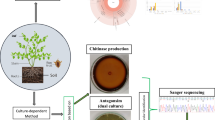Abstract
Seedling roots of Pseudotsuga menziesii were colonized with three monokaryotic isolates and one dikaryotic isolate of Laccaria bicolor to assess the effect of fungal genotype on ectomycorrhiza formation. Ectomycorrhizas resulting from colonization by the dikaryotic isolate had a multilayered mantle and a cortical Hartig net. One monokaryotic isolate (ss7) formed ectomycorrhizas comparable in anatomy to those induced by the dikaryotic isolate. Two other monokaryotic isolates (ss5, ss1) failed to form mantles or Hartig nets. Roots colonized by these isolates developed characteristics indicating an incompatible reaction.
Similar content being viewed by others
References
Bogar GD, Smith FH (1965) Anatomy of seedling roots of Pseudotsuga menziesii. Am J Bot 52:720–729
Coleman MD, Bledsoe CS, Smit BA (1990) Root hydraulic conductivity and xylem sap levels of zeatin riboside and abscisic acid in ectomycorrhizal Douglas fir seedlings. New Phytol 115:275–284
Cordell CE, Marx SB, Maul SB, Owen JH (1987) Production and utilization of ectomycorrhizal fungal inoculum in the eastern United States. In: Sylvia DM, Hung LL, Graham JH (eds) North American Conference on Mycorrhizae. IFAS, Gainesville, Fla, pp 287–289
Debaud JC, Gay G, Prevost A, Lei J, Dexheimer J (1988) Ectomycorrhizal ability of genetically different homokaryotic and dikaryotic mycelia of Hebeloma cylindrosporum. New Phytol 108:323–328
Dixon RK, Garrett HE, Stelzer HE (1987) Growth and ectomycorrhizal development of loblolly pine progenies inoculated with three isolates of Pisolithus tinctorius. Siv Genet 36:240–245
Ducamp M, Poitou N, Olivier JM (1986) Comparison cytologique et biochimique entre culture monospores et boutures du carpophores chez Suillus granulatus (fr. ex L.) Kuntze. In: Gianinazzi-Pearson V. Gianinazzi S (eds) Physiological and genetical aspects of mycorrhizae. INRA, Paris, pp 575–579
Fortin JA, Piché Y, Lalonde M (1980) Technique for the observation of early morphological changes during ectomycorrhiza formation. Can J Bot 58:361–365
Gardes M, White TJ, Fortin JA, Bruns TD, Taylor JW (1991) Identification of indigenous and introduced symbiotic fungi in ectomycorrhizae by amplification of nuclear and mitochondrial DNA. Can J Bot 69:180–190
Harley JL, Smith SE (1983) Mycorrhizal symbiosis. Academic Press, New York
Kottke I, Oberwinkler F (1986) Mycorrhiza of forest trees — structure and function. Trees 1:1–24
Kropp BR, Fortin JA (1988) The incompatibility system and relative ectomycorrhizal performance of monokaryons and reconstituted dikaryons of Laccaria bicolor. Can J Bot 66:289–294
Kropp BR, McAfee BJ, Fortin JA (1987) Variable loss of ectomycorrhizal ability in monokaryotic and dikaryotic cultures of Laccaria bicolor. Can J Bot 65:500–504
Lamhamedi MS, Fortin JA, Kope HH, Kropp BR (1990) Genetic variation in ectomycorrhiza formation by Pisolithus arhizus on Pinus pinaster and Pinus banksiana. New Phytol 115:689–697
Malajczuk N, Molina R, Trappe JM (1984) Ectomycorrhiza formation in Eucalyptus. II. The ultrastructure of compatible mycorrhizal fungi and associated roots. New Phytol 96:43–53
Marx DH (1969) The influence of ectotrophic mycorrhizal fungi on the resistance of pine roots to pathogenic infections. I. Antagonism of mycorrhizal fungi to root pathogenic fungi and soil bacteria. Phytopathology 59:153–163
Marx DH, Bryan WC (1971) Pure culture synthesis of ectomycorrhizae by Thelephora terrestris and Pisolithus tinctorius on different conifer hosts. Can J Bot 22:338–341
Molina R, Massicotte H, Trappe JM (1992) Specificity phenomena in mycorrhizal symbiosis: community-ecological consequences and practical implications. In: Allen MF (ed) Mycorrhizal functioning: an integrative plant-fungal process. Chapman and Hall, New York, pp 357–423
Nylund JE (1980) Symplastic continuity during Hartig net formation in Norway spruce ectomycorrhizae. New Phytol 86:373–378
Peterson RL, Farquhar ML (1994) Mycorrhizas — integrated development between roots and fungi. Mycologia 86:311–326
Richter DL, Bruhn JN (1989) Revival of saprophytic and mycorrhizal Basidiomycete cultures from cold storage in sterile water. Can J Microbiol 35:1055–1060
Sampagni R, Perrin R, LeTacon F (1986) Disease suppression and growth promotion of Norway spruce and Douglas-fir seedlings by the ectomycorrhizal fungus Laccaria laccata in forest nurseries. In: Gianinazzi-Pearson V, Gianinazzi S (eds) Proceedings of the First European Symposium on Mycorrhizae. INRA, Paris, pp 799–806
Sinclair WA, Cowles DP, Hee SM (1975) Fusarium root rot of Douglas fir seedlings: suppression by soil fumigation fertility management and inoculation with spores of the fungal symbiont Laccaria laccata. For Sci 21:390–399
Sinclair WA, Sylvia DM, Larson AO (1982) Disease suppression and growth promotion in Douglas fir seedlings by the ectomycorrhizal fungus Laccaria laccata. For Sci 28:191–201
Sylvia DM, Sinclair WA (1983) Phenolic compounds and resistance to fungal pathogens induced in primary roots of Douglas fir seedlings by the ectomycorrhizal fungus Laccaria laccata. Phytopathology 73:390–397
Tonkin CM, Malajczuk N, McComb JA (1989) Ectomycorrhizal formation by micropropagated clones of Eucalyptus marginata inoculated with isolates of Pisolithus tinctorius. New Phytol 111:209–214
Trappe J, Strand RF (1969) Mycorrhizal deficiency in a Douglas-fir region nursery. For Sci 15:381–389
Villeneuve N, LeTacon F, Bouchard D (1991) Survival of inoculated Laccaria bicolor in competition with native ectomycorrhizal fungi and effects on the growth of outplanted Douglas-fir seedlings. Plant Soil 135:95–107
Wong KKY, Fortin JA (1990) Root colonization and intraspecific mycobiont variation in ectomycorrhiza. Symbiosis 8:197–231
Wong KKY, Piché Y, Montpetit D, Kropp BR (1989) Differences in the colonization of Pinus banksiana roots by sib-monokaryotic and dikaryotic strains of ectomycorrhizal Laccaria bicolor. Can J Bot 67:1717–1726
Wong KKY, Montpetit D, Piché D, Lei J (1990a) Root colonization by four closely related genotypes of the ectomycorrhizal Basidiomycete Laccaria bicolor (Maire) Orton — comparative studies using electron microscopy. New Phytol 116:669–679
Wong KKY, Piché Y, Fortin JA (1990b) Differentiated development of root colonization among four closely related genotypes of ectomycorrhizal Laccaria bicolor. Mycol Res 94:876–884
Author information
Authors and Affiliations
Rights and permissions
About this article
Cite this article
Lumley, T.C., Farquhar, M.L. & Peterson, R.L. Ectomycorrhiza formation between Pseudotsuga menziesii seedling roots and monokaryotic and dikaryotic isolates of Laccaria bicolor . Mycorrhiza 5, 237–244 (1995). https://doi.org/10.1007/BF00204956
Issue Date:
DOI: https://doi.org/10.1007/BF00204956




